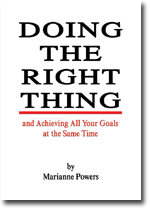Genius at Work

Is Your Genius at Work?: 4 Key Questions to Ask before Your Next Career Move
I told him my genius was problem-solving. He said, "'Problem-solving' sounds like a process at the outside of the onion you must peel. So...What is your unique process for solving problems?"
The way I solve problems is:
1. Start with knowing for a certainty that there is a solution to every problem and that I am capable of finding it or at least of finding the people who can find it.
2. Ask if what seems to be a problem is really a problem. If someone else has brought it to me, I ask "What makes you think that this is a problem" or "What problem are you trying to solve". Sometimes people say that something is a problem when it's really just a broken-down solution that doesn't work anymore. You might want to fix what they bring you or you might want to throw that out and handle the problem a completely different way. For example, if the toaster doesn't work any more, the problem is not that the toaster is broken, the problem is that you want toast and you can't make it. There is only one solution to the first, fixing the toaster. But there are lots of solutions to the second -- fixing the toaster, buying a new toaster, borrowing someone else's toaster, making toast on the stove, or doing without toast.
3. Get up very close to the problem. Look it all over in detail. Ask other people what it looks like from their point of view. Take it apart, if possible. Look at all the pieces. Understand how they work and how they work together. Sometimes the answer is obvious.
4. If looking at it up close doesn't give you the solution, start moving back from it. As you move back, you gain perspective. You can see other possible solutions or whether there is a way around the problem. When you look at it up close, there's only you and the problem. When you start moving back from it, there's you and the problem and the people and things immediately around it. If you move back far enough, there's you and the problem and all the people in the world and all the resources in the world. With all the people and resources in the world, the problem hasn't got a chance. You just have to let your mind consider all the possibilities that are there -- not just what has been done in the past, no just the standard way this problem is handled, but anything in the whole world that could be used to solve the problem.



0 Comments:
Post a Comment
<< Home